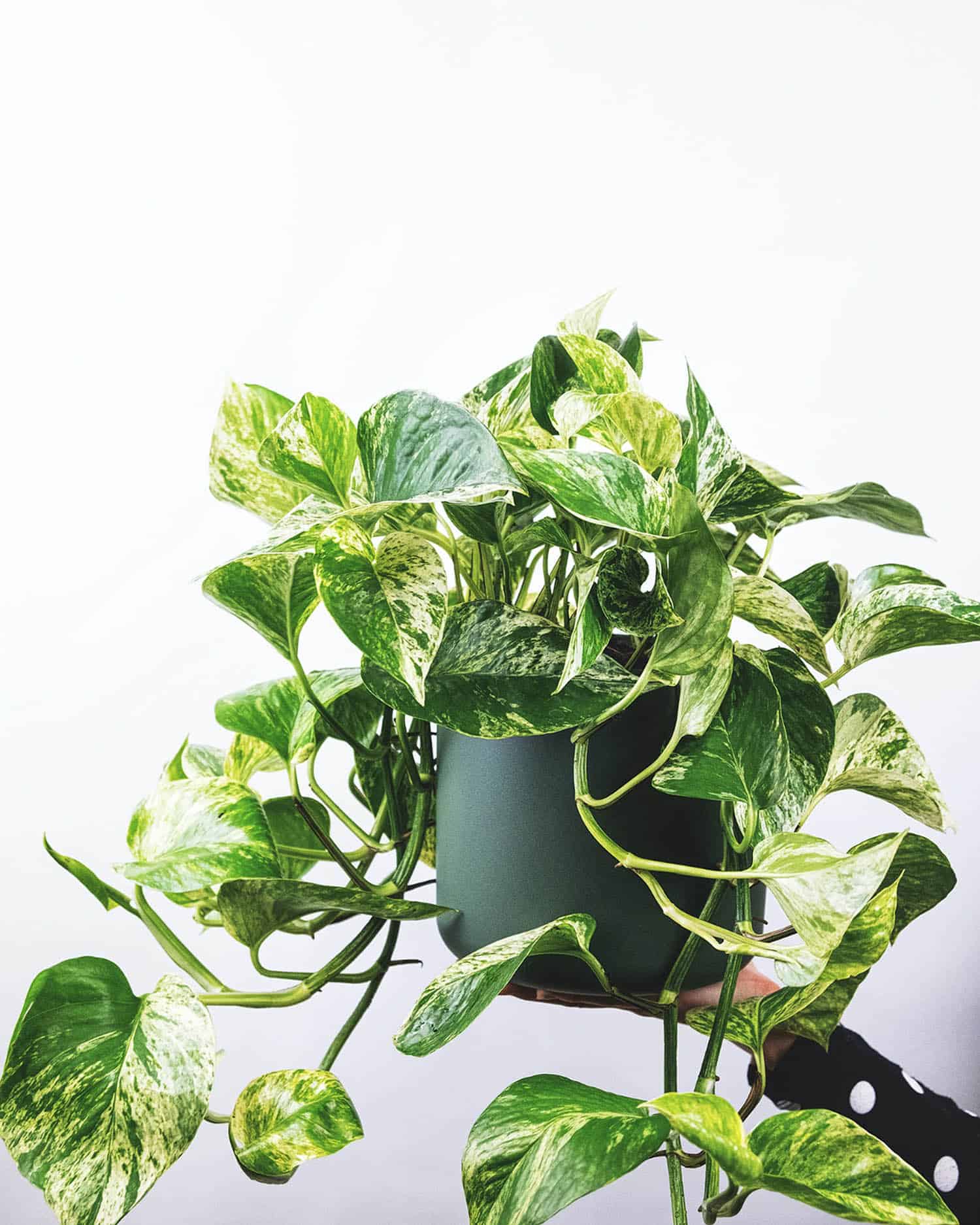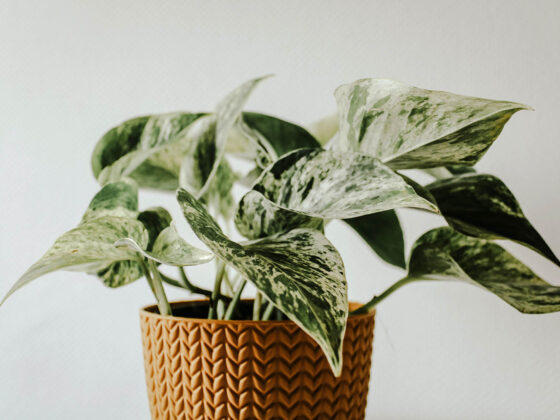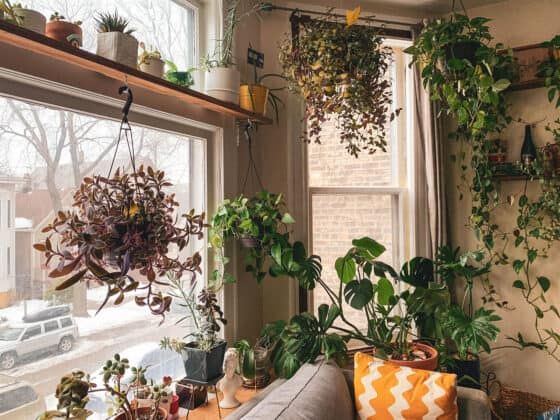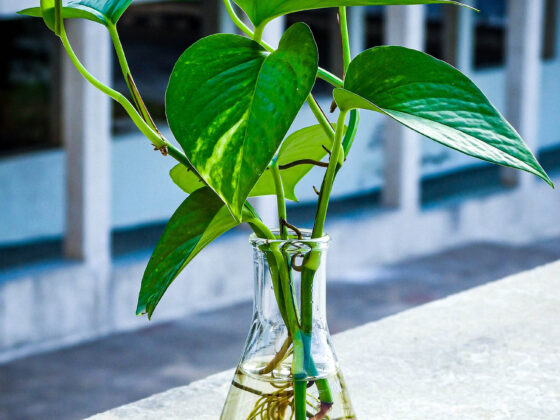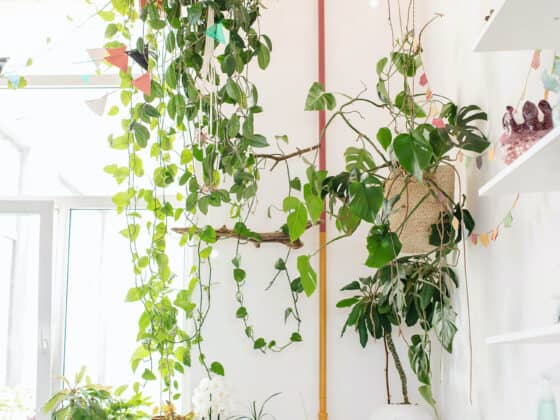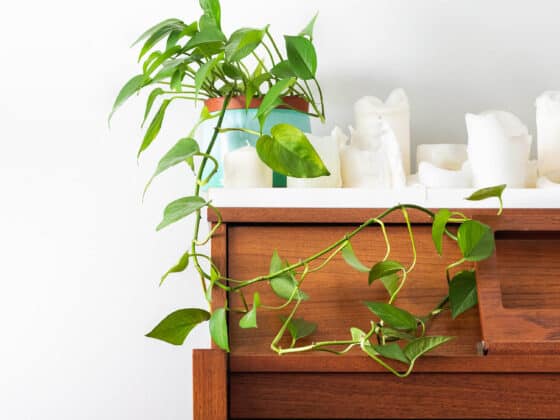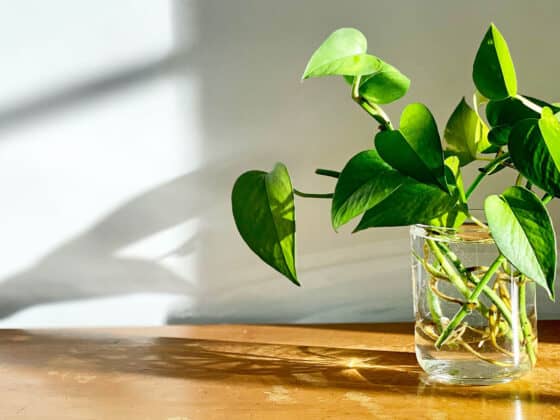Variegation is one of the coolest visual quirks that a houseplant can have. But can a Pothos plant be variegated? Absolutely! Variegated Pothos plants are actually quite common, even though they’re technically mutants. Many people love the looks of multicolored Devil’s Ivy, and there are plenty of growers eager to meet that demand. So what makes a Pothos variegated? And what do they need to thrive?
Pothos variegation arises because of mutations in the cells that disrupt chlorophyll production. This creates patches of different colors, usually bright yellow or creamy white. A variegated Pothos plant needs more sun than normal because the mutated patches are less effective at photosynthesis.
There are several well-known types of variegated Pothos that you can buy if you’re looking for specific color patterns. We’ll explain how to identify them and what you can do to keep them from losing their striking variegation. And we’ll address some common questions, concerns, and misconceptions about these beautiful and intriguing plants.
The Basics of Pothos Variegation
We’ll start with a brief introduction to variegation for those who are new to the topic. A variegated plant has multicolored leaves. Lighter shades like yellow or white appear side-by-side with patches of ordinary green.
Some plants have stable patterns of variegation built into their genomes. Many striking varieties of Calathea fall into this category. By contrast, variegated Pothos plants are always the result of mutation. Random patches of cells begin producing less chlorophyll, the pigment that makes leaves green, which results in a chaotic, multicolored appearance.
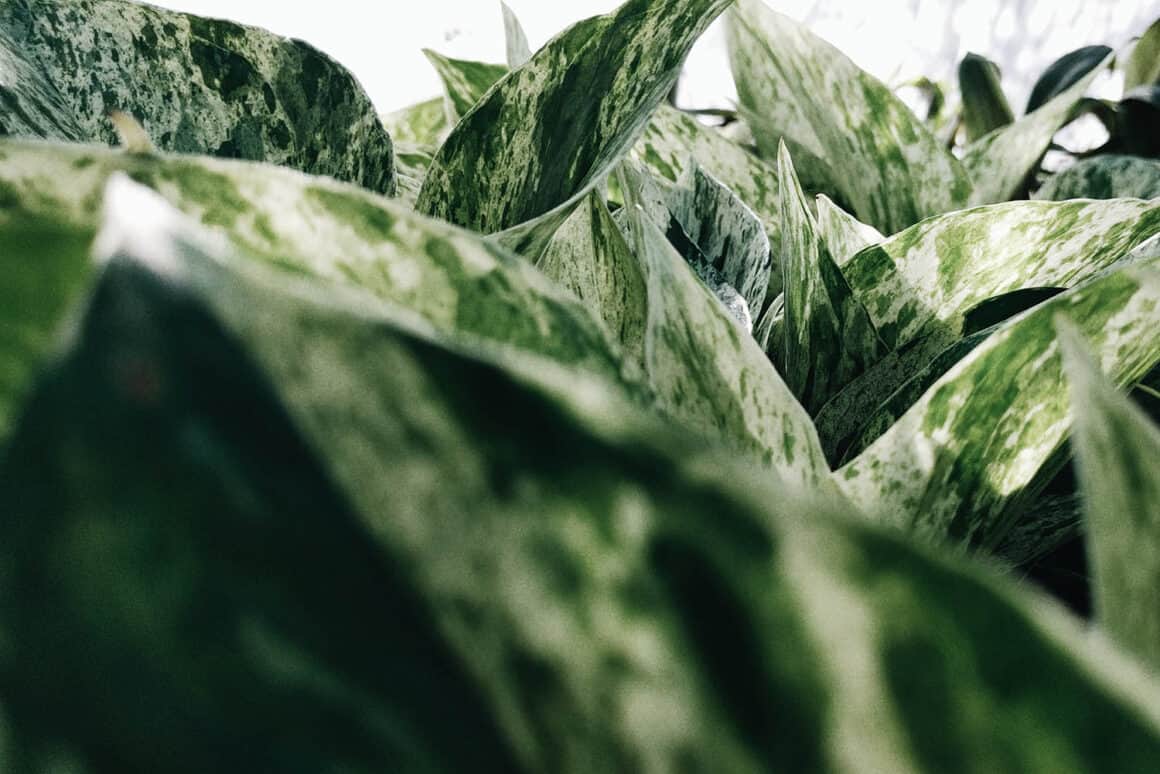
Some plants also develop reflective variegation, in which tiny air pockets form in the leaves and give them a slightly shiny silvery appearance. This is called chimeric (or sometimes chimeral) variegation. It’s harder to reproduce and harder to maintain. That makes it rarer, and in many cases, more valuable.
Pothos variegation most commonly comes in shades of yellow or light green. The scientific name for Devil’s Ivy actually hints at this trait – Epipremnum aureum means “Golden Pothos”. However, some varieties can also be splotched with white, or occasionally a silvery gray.
Is My Pothos Variegated?
In general, it’s easy to tell if you have a variegated Pothos. Look at the leaves: are they all one solid color? Or do they have splashes, dots, or streaks of another shade mixed in? If there’s more than one color, it generally means your Pothos is variegated.
However, there are a few other conditions that can sometimes be confused with variegation. These problems are especially likely if your ordinary green Pothos suddenly becomes multicolored. Spontaneous variegation is rare. When you see patches of another color showing up, make sure your Pothos doesn’t have:
Pest Damage
Certain types of bugs can damage the leaves of your plant in a way that might resemble variegation at first glance. Spider mites and thrips are particularly nasty in this regard. Their mouthparts pierce the leaves to suck out the sugary juices inside your plant, leaving little yellow scars behind.
Pest scarring usually looks like your Pothos has been misted with a fine spray of yellow or brown. It’s more blurry and indistinct than the large, well-defined splashes and dashes of color on a variegated Pothos plant. Affected leaves may curl up or wilt, and new growth can appear shriveled or twisted.
You can also look for the pests themselves. Thrips are tiny, but they move around a lot, and you can sometimes spot them crawling around over the leaves. Spider mites can be detected by holding a piece of white paper under the leaves of your Pothos and tapping on the stems. The mites will drop onto the paper and make it look like it’s dusted with pepper. Large spider mite colonies also spin wispy, dusty-looking webs on the leaves.
If your Pothos has a pest problem, isolate it from any other houseplants in your home. Then try to determine if the plant is salvageable. If so, rinse it thoroughly with a reasonably strong spray of water. Then spray down the leaves with a pest killer like insecticidal soap, neem oil (1 teaspoon per liter of water), hydrogen peroxide (use a 3% concentration, like you’d find in a first aid kit), or rubbing alcohol (1 part in 4 parts water).
Mosaic Virus
This is a broad term for several different plant viruses that can produce discolored patches on the leaves. It can sometimes be confused with variegation by the untrained eye.
However, if you know what you’re looking for, you can generally tell the two types of spotting apart. Variegation usually produces distinct areas of different colors on the leaves. The patches caused by mosaic virus have blurrier edges, as though the green color has rubbed or faded off. Mosaic viruses also never produce the white coloring you can see in some kinds of variegated Pothos. They only show up as yellow, green, or brown.
Leaf deformation is another indicator. The texture of infected leaves is often uneven and bumpy. The foliage can look crumpled or wrinkled, and the veins may be abnormally thin and yellow. And growth will tend to be stunted.
The good news is that mosaic viruses are very rare. The bad news is that if your Pothos does get this disease, it’s doomed. There’s no known cure, so if you’re sure your plant is infected, you’ll have to destroy it. Don’t just throw it on the compost pile, either!
Nutrient Deficiency
Indoor Pothos plants only have the nutrients you give them. That’s why it’s so important to supply your plant with fertilizer. If your Devil’s Ivy starts to turn multicolored, ask yourself: “Have I been supplementing its diet?” If the answer is “no”, your plant probably has a shortage of nutrients rather than variegation.
When it’s low on essential ingredients like manganese, nitrogen, and molybdenum, your Pothos may get pale spotting or speckling on its leaves. You can add some fertilizer and see if the discoloration goes away. But first, make sure there are no other issues preventing growth, like disease, pests, dehydration, or lack of sunlight.
Don’t worry about figuring out exactly which nutrient your Pothos needs. Any decent houseplant fertilizer will have the full complement of ingredients for plant growth. Start by adding a ¼ or ½ dose and see if that does the job.
Types of Variegated Pothos
If you have a variegated Pothos plant, there’s a good chance it’s one of these common types:
Golden Pothos
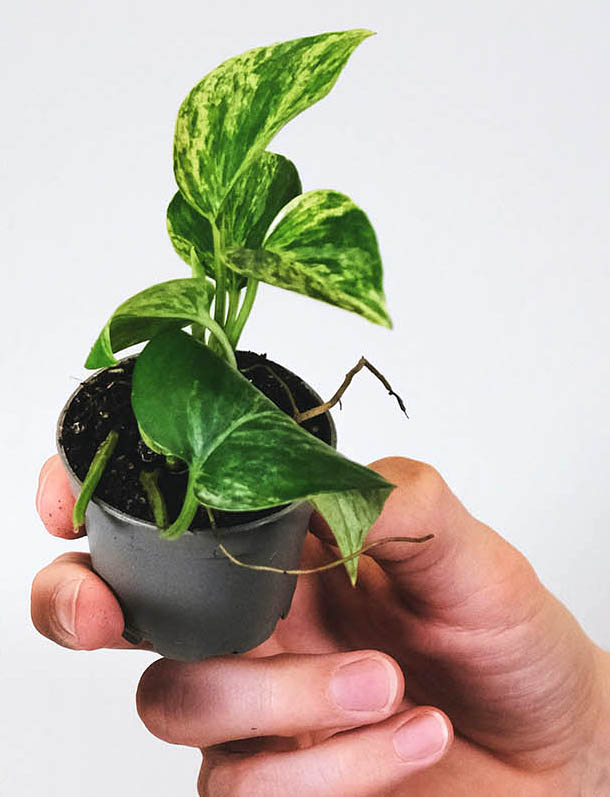
This variegated Pothos may actually be more common than the all-green kind. Its heart-shaped leaves are mostly green, but they’re flecked with bright yellow.
Jessenia Pothos
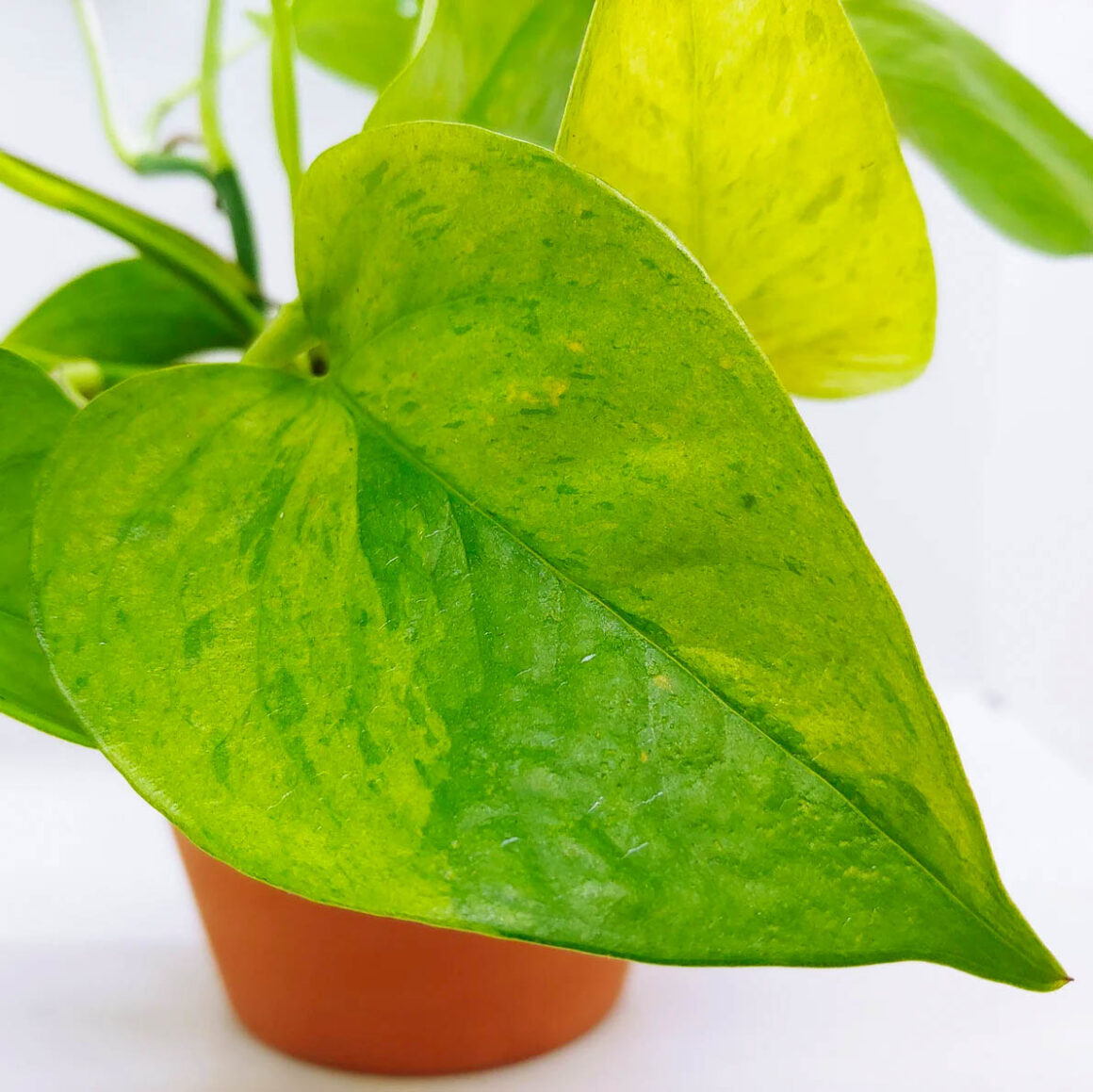
This cultivar looks a bit like an inversion of the Golden Pothos. The leaves are mostly yellow or lime-green, with speckles and dashes of darker green mixed in.
Neon Pothos
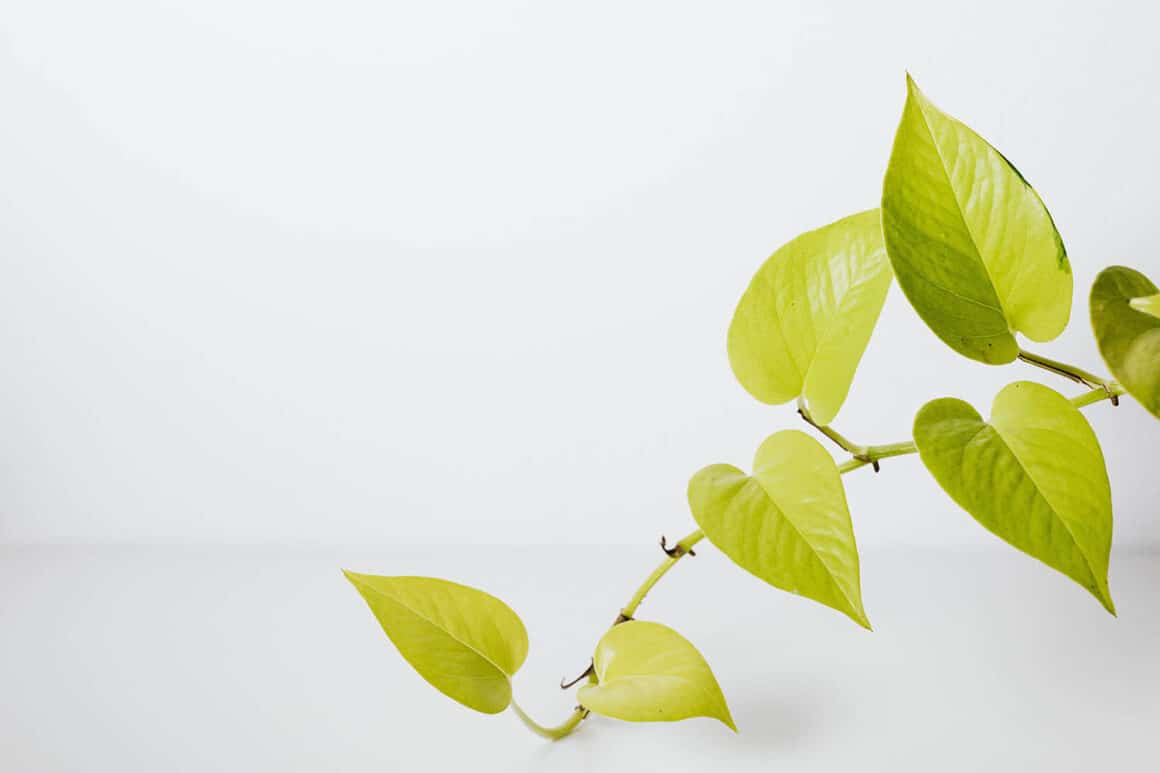
We should clarify a bit and say that not all neon Pothos are variegated. Some have uniform lemon-lime foliage. However, it’s very common for them to develop patches of dark green. On some neon Pothos plants, the variegation marks are small and infrequent. On others, they can take up more than half of the plant’s surface area.
Marble Queen Pothos
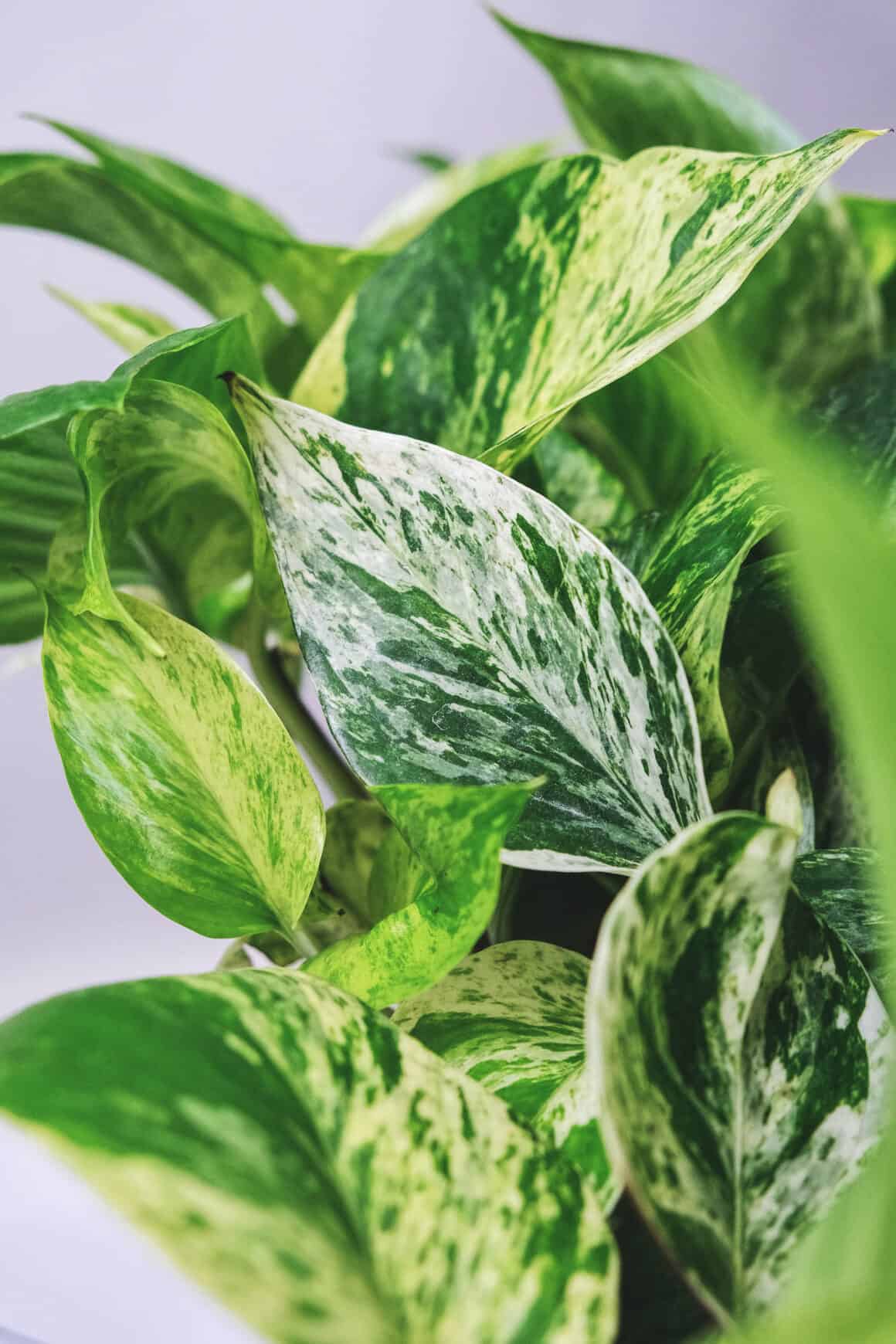
The Marble Queen is a dramatically variegated Pothos featuring large streaks of white. With so little chlorophyll, it tends to be one of the slowest-growing Pothos varieties.
N’Joy Pothos and Pearls and Jade Pothos
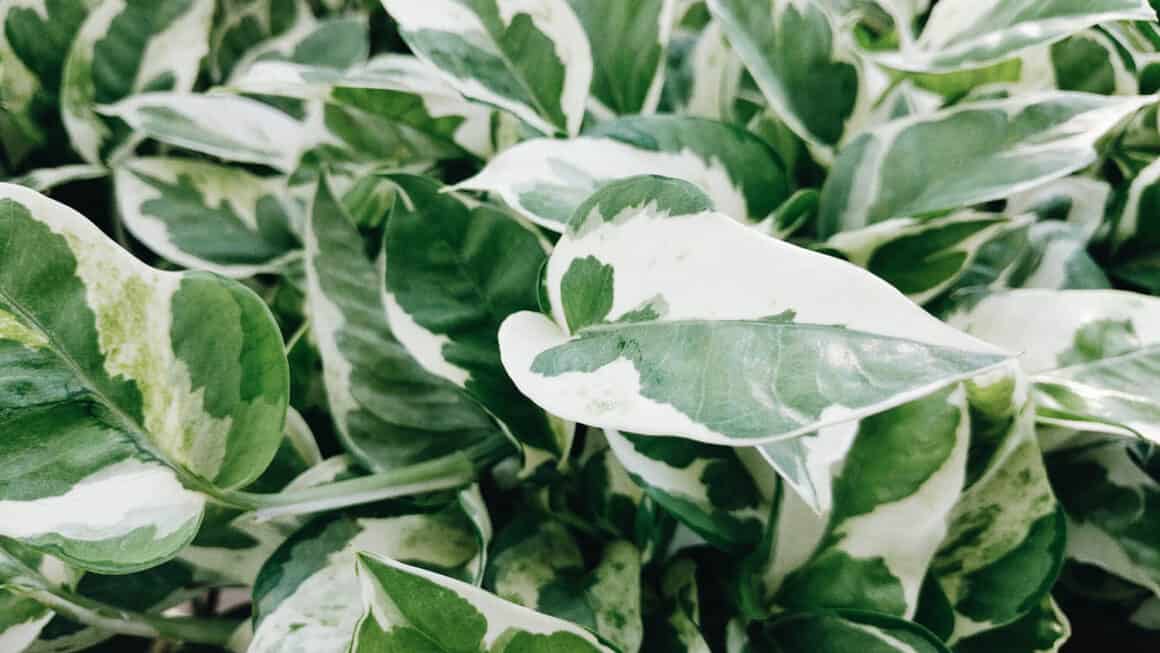
N’joy Pothos is perfect for anyone who likes camo patterns, this Pothos produces distinct patches of dark green, pale green, and creamy off-white.
Pearls and Jade Pothos is easy to confuse with the N’Joy, as they have almost identical variegation patterns. There are two major differences. First, the white variegation in a Pearls and Jade Pothos clusters more heavily at the edges of the leaves. Second, the white areas may have sprays of green inside them, while they’re always solid-colored on an N’Joy.
Snow Queen Pothos
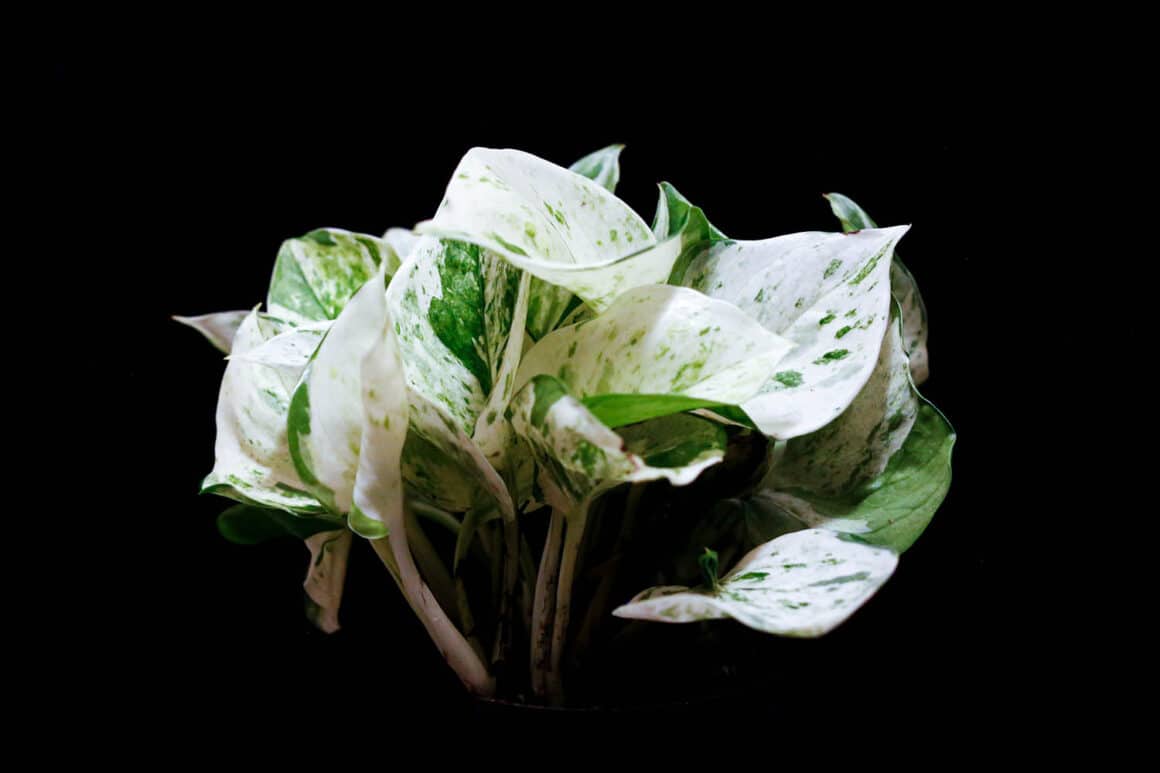
The Snow Queen is quite similar to the Marble Queen, but with even larger and brighter white patches. Its leaves may appear mostly white, with just a few dots of green. They also tend to be longer and pointer than those of the Marble Queen.
Manjula Pothos
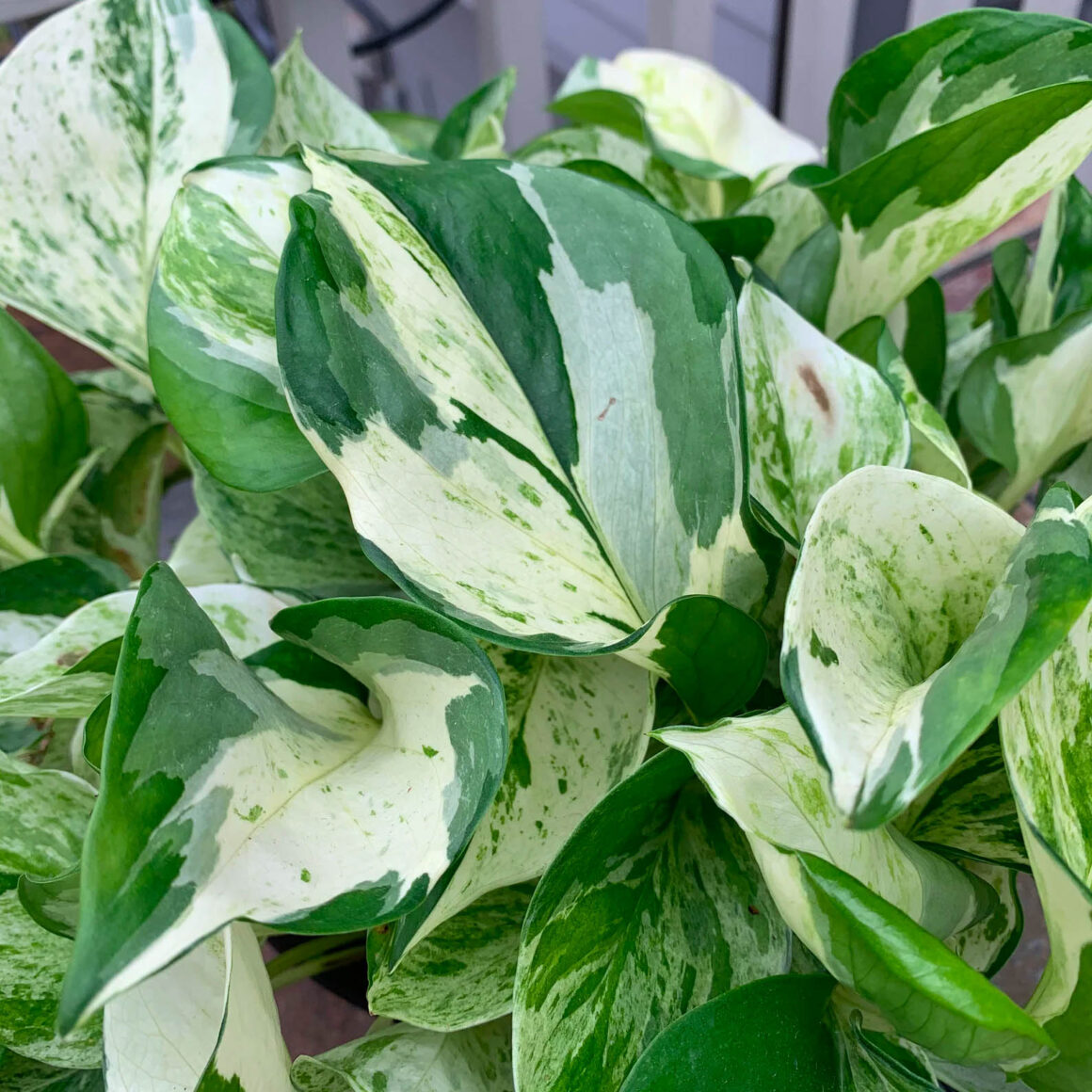
The defining features of the Manjula Pothos are its rounder, fatter leaves and highly varied coloring. A single leaf can combine dark green, pale green, lime green, and cream-white.
Satin Pothos (AKA Silver Pothos)
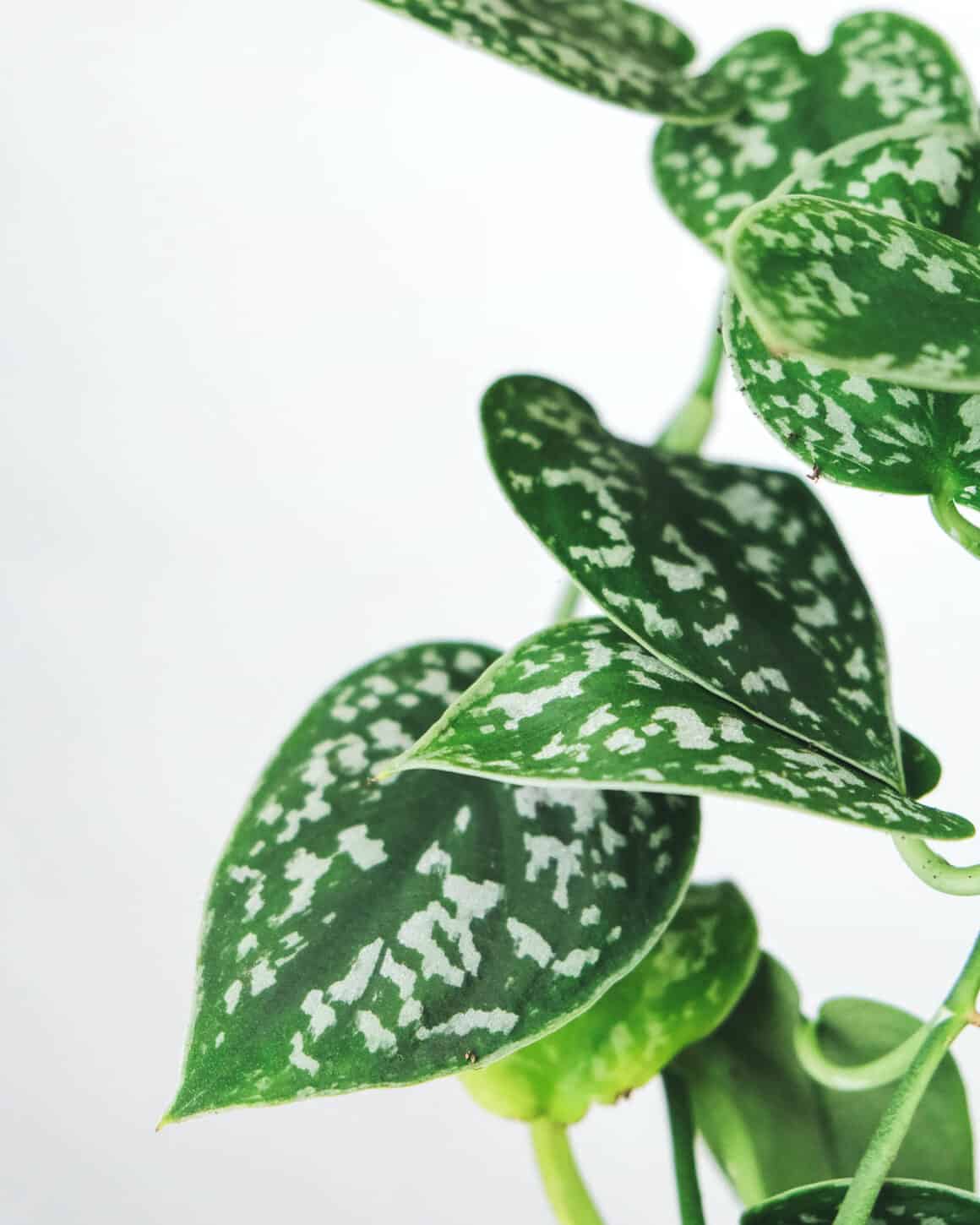
Though it’s usually called a Pothos, this is a different type of plant belonging to the Scindapsus genus. It’s got distinctive spots of silver-gray. See here for more on the similarities and differences between Scindapsus and Epipremnum.
Where to Find a Variegated Pothos
Did any of the Pothos varieties above make you swoon? Are you wondering where you can get your own spotted, striped, or speckled Devil’s Ivy? We have some wonderful news: they’re everywhere.
Your local plant store or garden center probably has at least one or two variegated Pothos plants right now. The most common types are the Golden, Silver, and Marble Queen Pothos. If you’re looking for something a little rarer, like a Jessenia or a Manjula Pothos, Etsy is probably your best bet.
When buying a variegated Pothos online, it’s best to get a full plant (roots and all) when possible. Get a picture from the seller so you can assess the level of variegation. The next-best option is to get a good-sized stem cutting that includes a few leaves. In general, a more multicolored cutting will grow into a more multicolored plant.
Steer clear of anyone claiming to sell Pothos seeds. These plants never flower and fruit without help from artificial hormones. And even if you could produce seeds, Pothos variegation can’t be passed on that way.
Caring For a Variegated Pothos
Once you get a variegated Pothos plant, how can you help it thrive? For the most part, you should care for them just like their single-colored relatives:
- Water only when needed. Wait until the top 1-2 inches of potting mix feel dry, then soak the soil thoroughly. Check every 2-3 days in the summer and every 3-5 days in the winter. When in doubt, wait an extra day and check again. Dehydration is bad, but overwatering is much worse.
- Provide airy, chunky soil. The right soil for a Pothos plant includes lots of coarse ingredients to leave room for airflow. It should also have some squishy organic material to hold water. For a simple but effective recipe, try combining 40% perlite, 30% coco coir, 20% orchid bark, and 10% worm castings.
- Keep the humidity high when possible. Your Pothos is adapted for the jungle, and it’s happiest when the relative humidity is between 50% and 80%. You can control this directly with a humidifier, or use a variety of small tricks to enhance the humidity level. Tactics like clustering tropical plants together, keeping them in humid spaces like bathrooms, and placing them on pebble trays can help.
- Fertilize in moderation. You should be giving your plant regular doses of fertilizer during the growing season. As we suggested earlier, it’s often best to begin with a milder concentration than the packaging suggests. You can always increase it later on, but fertilizing too much can cause crispy leaf tips and edges.
As we said, all this is fairly standard for Epipremnum plants. However, there is one important factor that a variegated Pothos needs more of:
Variegated Pothos and Sunlight
The lively colors of a variegated Pothos come from spots where the chlorophyll concentration is reduced. And chlorophyll is necessary for photosynthesis. This means that a variegated leaf can’t absorb as much sunlight as a solid green leaf of the same size.
Your variegated Pothos, therefore, needs more sunlight to sustain the same amount of growth. Place it in a bright location where it won’t get more than 2-3 hours of direct sunlight per day. You can follow the broad strokes of our lighting advice in this article, but remember that a variegated plant has much less tolerance for dim spaces. If possible, look for an east-facing sill or a south-facing room where you can keep your Pothos 4-5 feet from the window.
Try to make sure your plant is getting at least 8-10 hours of bright sun every day. If you can provide more, that’s even better. You can also use a grow light to give your variegated Pothos some extra energy. Pair it with an outlet timer to regulate the lighting schedule. 6-8 hours per day makes a good supplement for natural light. If you’re growing your Pothos entirely under artificial light, shoot for 10-12 hours.
As with most houseplants, it’s possible to provide too much sun as well as too little. Watch for signs of sun damage: large, irregular patches of crispy brown on the parts of the plant that are exposed to the light.
Why Is My Pothos Losing Variegation?
The chimeric patterning that you see in a Pothos is fairly unstable. Pothos variegation can revert, meaning that the plant can go back to producing only green leaves. Unfortunately, this is hard to predict or control.
The one way you can help keep your Pothos variegated is by providing lots of light. The most common reason for your plant to revert is that it’s not getting enough sun. The plant tries to maximize its chlorophyll production to soak up as many of the limited rays as possible.
It’s also a good idea to propagate your Pothoos regularly. If you have a few different variegated Pothos plants, it’s less of an issue if one of them reverts. Take cuttings every so often and plant them in new pots. Or put one or two back into the same pot they came from, making your Pothos more full and bushy.
Note that reversion isn’t always permanent. It’s not unheard of for a plant to grow nothing but green for a year or more, only to suddenly pop up a new variegated leaf.
Can You Encourage Variegation in Pothos?
So a variegated Pothos plant can revert to green – but can the process work the other way? Unfortunately, there’s not a reliable way to induce variegation in these plants. When it happens, it’s due to a random genetic mutation.
In theory, you could increase your odds by exposing the plant to radiation or mutagenic chemicals. In practice, this is difficult, dangerous, and more likely to kill your plant than improve its coloration. We recommend leaving this to the professionals.
On the other hand, if your Pothos already has some variegation, you can sometimes encourage it to produce more. If you’ve been following along so far, you may have guessed how. That’s right: give it more light. A grow light can be a helpful tool if you don’t have a sunnier spot where you can put your Pothos.
Final Thoughts
The bold patterns of variegated Pothos plants can add a fun flair to any houseplant collection. Just remember not to skimp on the sunlight. And take lots of cuttings to keep the variegation going strong! Have fun tending to your dappled and colorful Pothos plants.






